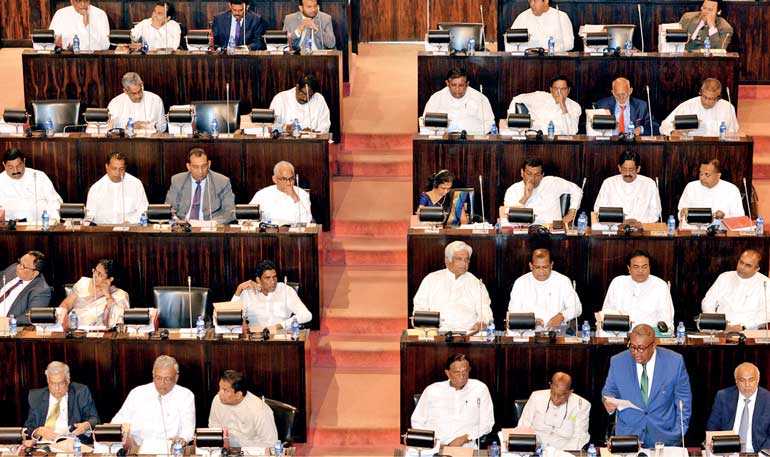Tuesday Apr 22, 2025
Tuesday Apr 22, 2025
Thursday, 19 September 2019 00:25 - - {{hitsCtrl.values.hits}}

Commonwealth countries collectively have declared that their ambition is to ensure 30% of the political sphere is made up of women. This is a step on the way to achieving gender parity – Pic by Shehan Gunasekara
This month the Commonwealth Women’s Affairs Ministers Meeting will assemble in Nairobi, Kenya. It has taken place regularly since 1985, to take stock of the current status of gender equality in our member countries, and to share perspectives and experience of how progress on this important Commonwealth priority can be achieved more swiftly. Recommendations and decisions made by ministers responsible for women’s affairs and gender will go forward to the Commonwealth Heads of Government Meeting being convened in Rwanda next year. 
The past century has witnessed the greatest advances for gender equality in human history. From New Zealand becoming the first self-governing country in 1893 to allow women to vote in parliamentary elections to Sri Lanka electing the world’s first female Prime Minister in 1960, the gender gap has never narrowed so quickly, but there is still much ground to be gained.
In order to assess and accelerate progress, considerable efforts are now made by multilateral organisations to measure progress against indicators linked to gender equality and women’s empowerment. So we know, for instance, that in the Commonwealth a girl is as likely to attend primary school as a boy, and in some countries more so. In the parliaments of 13 Commonwealth countries, 30% or more of members are women. Women everywhere can now expect to outlive men.
Yet against this progress, underlying systemic inequality remains persistent and widespread.
The past century has witnessed the greatest advances for gender equality in human history. From New Zealand becoming the first self-governing country in 1893 to allow women to vote in parliamentary elections to Sri Lanka electing the world’s first female Prime Minister in 1960, the gender gap has never narrowed so quickly, but there is still much ground to be gained
In politics, only one in five parliamentarians is a woman. In education, of every 10 girls only seven attend secondary school. In the workplace, the law in 32 countries does not mandate equal remuneration for work of equal value. In social life, 19 countries do not have legislation prohibiting early marriage.
That is according to research undertaken by the Commonwealth Secretariat in preparation for the Women’s Affairs Ministers Meeting in Kenya. This research offers a snapshot of progress towards gender equality within and across the Commonwealth in four priority areas: women in leadership, women’s economic empowerment, ending violence against women and girls, and gender and climate change.
Women in leadership
Commonwealth countries collectively have declared that their ambition is to ensure 30% of the political sphere is made up of women. This is a step on the way to achieving gender parity.
Rwanda is one of only three countries in the world to have achieved gender parity, with over 55% of seats occupied by women in both of its houses of parliament.
In 13 Commonwealth member countries, 30% or more of members of parliament are women. The countries of our Caribbean and Americas region have an average of almost 25% female parliamentarians, which is relatively high compared to other Commonwealth regions.
Ten Commonwealth countries have achieved the target of 30% or more women ministers, and Canada leads with over 50%.
Women’s economic empowerment
Although gender gaps in enrolment and achievement in education have narrowed, this has not yet translated satisfactorily into women’s equal participation in the formal labour force, or the elimination of the gender pay gap once women are in the workforce.
The pan-Commonwealth average for female labour force participation is 56.30%, which means that only just over one in two of women work in the formal sector. Rwanda, at 86%, has the highest percentage of women’s participation in the labour force.
In order to realise the Sustainable Development Goals by 2030, it is important for us to continue to working together multilaterally, and to invest more resources and effort towards ending the inequalities between women and men
Our analysis shows a disjunction in the transition from primary to secondary schools for girls, largely due to factors such as the cost of education, child marriage or labour, and violence against girls. The highest female enrolment in secondary schools is in Canada with 100%.
Twenty of our member countries do not have legislation on sexual harassment in employment, while 23 do not have criminal penalties or civil remedies for sexual harassment in the workplace.
Violence against women and girls
Prevalence of violence against women and girls remains high throughout the world, despite advances in women’s economic status, leadership and agency.
Of our 53 Commonwealth member countries, 47 have laws against domestic violence; 20 have legislation that explicitly criminalises marital rape; 40 have legislation against sexual harassment; and nine have legislation that offers broad protections for LGBTI people.
Gender and climate change
Despite being high on the international agenda since the UN Conference on Environment and Development in 1992, the issue of gender and climate change has still not achieved its due recognition.
Our Commonwealth studies show that a higher proportion of women are found in employment that is vulnerable to climate change, and that at least 80% of green jobs globally are expected to be in the secondary sectors such as construction, manufacturing and energy production – industries where women are already underrepresented.
Through mutual support and cooperation – and particularly through our regular Women Affairs Ministers Meetings – the member countries of the Commonwealth continue to put in place laws, policies, plans and programs to address gender inequality and women’s empowerment. These contribute to the fulfilment of commitments made by heads of government in accordance with the values and principles of the Commonwealth Charter, and of other international declarations and mechanisms including the Beijing Platform for Action.
It is clear that for gender equality to become a reality, responsibility for action has to be mainstreamed across the political sphere, public and private sectors, and civil society. This approach is a key tenet of the Beijing Platform for Action, and as we approach the 25th anniversary of that declaration, there is a special opportunity to focus on the contributions it can make towards national policy-making, budgeting, planning and service delivery.
In order to realise the Sustainable Development Goals by 2030, it is important for us to continue to working together multilaterally, and to invest more resources and effort towards ending the inequalities between women and men.
Our Women Affairs Ministers Meeting is a fine example of such multilateral collaboration in action – and indeed the Commonwealth shines as a beacon for what can be achieved through the mutual support and encouragement of international cooperation conducted on a basis of inclusiveness and equality.
(Note: Data against some parameters is missing in a few countries. The research analysis comes from the Commonwealth annual report on gender equality 2018/19, which will be released later this year.)
(The writer is the Commonwealth Secretary-General.)
Discover Kapruka, the leading online shopping platform in Sri Lanka, where you can conveniently send Gifts and Flowers to your loved ones for any event including Valentine ’s Day. Explore a wide range of popular Shopping Categories on Kapruka, including Toys, Groceries, Electronics, Birthday Cakes, Fruits, Chocolates, Flower Bouquets, Clothing, Watches, Lingerie, Gift Sets and Jewellery. Also if you’re interested in selling with Kapruka, Partner Central by Kapruka is the best solution to start with. Moreover, through Kapruka Global Shop, you can also enjoy the convenience of purchasing products from renowned platforms like Amazon and eBay and have them delivered to Sri Lanka.
Discover Kapruka, the leading online shopping platform in Sri Lanka, where you can conveniently send Gifts and Flowers to your loved ones for any event including Valentine ’s Day. Explore a wide range of popular Shopping Categories on Kapruka, including Toys, Groceries, Electronics, Birthday Cakes, Fruits, Chocolates, Flower Bouquets, Clothing, Watches, Lingerie, Gift Sets and Jewellery. Also if you’re interested in selling with Kapruka, Partner Central by Kapruka is the best solution to start with. Moreover, through Kapruka Global Shop, you can also enjoy the convenience of purchasing products from renowned platforms like Amazon and eBay and have them delivered to Sri Lanka.